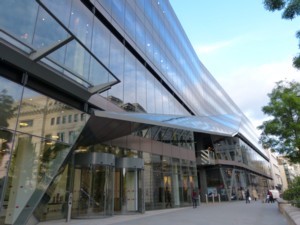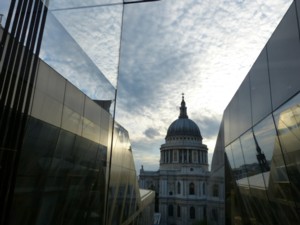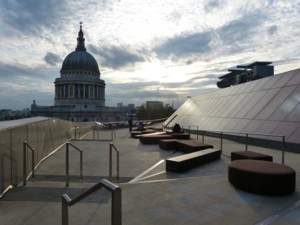We are developing the social individualist meta-context for the future. From the very serious to the extremely frivolous... lets see what is on the mind of the Samizdata people.
Samizdata, derived from Samizdat /n. - a system of clandestine publication of banned literature in the USSR [Russ.,= self-publishing house]
|
Not being wise in the ways of Twitter, I am not sure where Mr Eugenides got this piece of simple but effective graphics, only that he either acquired it or created it, one way or another, and that I found out about it because it was one of David Thompson’s clutch of ephemera last Friday:
I recall reading in one of Professor Parkinson’s books, I think in his classic Parkinson’s Law, that people only find it easy to have strong opinions about sums of money, or circumstances generally, that are within their particular and usually rather limited range of experience. So it is that a local planning committee will spend an hour arguing about a cheap loft extension, while nodding through an entire hundred million quid power station without discussion. Something along those lines. True, I suspect. Certainly true of many people.
So, the thing to do, with these otherwise unimaginably huge sums of money that politicians are slinging around nowadays, to keep all their various financial plates on sticks spinning fast enough, is what is done here, in the above graphic. Divide them all by the same (very large) number, until the original numbers become regular numbers of the sort regular people can relate to, while the numbers all nevertheless retain their relative sizes, to each other. The essential nature of what is going on is thus laid bare, for people who might otherwise be blinded by all the zeros, and all those bewildering words ending in “-illion”.
I agree with Mr Eugenides. This is clever.
And no, he didn’t invent it. It’s been around for a while.
I understand there’s a new sheriff in town. Who wants to kill him?
– said by the boss cowboy with the mustache (Slim Pickens?) in Blazing Saddles, to an enthusiastic response.
Blazing Saddles, what with Sheriff Obama and all, is now downright prophetic, in the sense that there must be Democrats who think they are living in this movie right now.
It’s showing on Brit TV right now. Earlier I set my TV hard disc to record this, and I just switched on my telly to catch that line.
I found Michael Barone’s piece here (thank you Instapundit) about ideological self-sorting very thought provoking.
Barone mentions a book called The Big Sort, which says that such self-sorting within the USA is bad, because it is “tearing us apart”. The book, says Barone:
… describes how Americans since the 1970s have increasingly sorted themselves out, moving to places where almost everybody shares their cultural orientation and political preference – and the others keep quiet about theirs.
Thus professionals with a choice of where to make their livings head for the San Francisco Bay Area if they’re liberal and for the Dallas-Fort Worth Metroplex (they really do call it that) if they’re conservative. Over the years the Bay Area becomes more liberal and the Metroplex more conservative.
Barone only concerns himself with how such self-sorting might be affecting the upcoming Presidential election, speculating that it causes liberals to live in an ideological cocoon and be bad at dealing with criticisms of their opinions. He instances the claim that Obamacare is unconstitutional, which liberals only took seriously when the Supreme Court suddenly did. Liberals had had months to prepare counter-arguments to that argument, or to rejig Obamacare so that it didn’t clash with the Constitution, but they saw no need to do either.
But there is plenty more to be said about ideological self-sorting. Might ideological self-sorting in due course become a major global tendency, with people choosing not just localities within countries, but actual countries, on ideological grounds? Is that already happening to any significant degree? If not, how likely is it that it might? And if it did start or has started, what might be its consequences?
The self-sorting Barone refers to is happening because moving within the USA is now quite easy. But time was when moving anywhere else was far harder, yet some people still did it, to particularly enticing destinations, from particularly abominable starting points. That people tried to hard to get out of the old USSR was one of the most damning and least answerable criticisms made against that horrible place.
The USA itself, all of it, is an exercise in ideological self-sorting, in the sense that most Americans are descended from people who bet the farm, metaphorically and often literally, on life in America being a better bet, even if they started out in America only with what they could carry. Americans are mostly descended from people who took a huge chance to make hugely better things happen for them. The great American exception to this is Americans descended from slaves, or from American natives. African slaves shipped to America placed no bets. They were chips in bets placed by others. Does that fact illuminate the seemingly still rather fraught relationship between black America and the rest of America? I think: yes.
But I am digressing into American history. What of the future of the world?
As a libertarian, I like the idea of ideological self-sorting, partly because it seems to me that there is a huge imbalance, in favour of minimal statism and against maximal statism, when it comes to how well each works out when practised only locally. Remember all those mental agonies suffered by Soviet communists when they started to realise that they were going to have to make do with “socialism in one country”, rather than everywhere? And remember how easy it then became to see which was better, Communism or not-Communism? Most of the world’s collectivists, although there are surely exceptions to this generalisation, are now collectivisms whose entire purpose is to deny “free riders” their free ride, anywhere on earth, thereby denying not only choice but exit. For collectivists, a world in which anti-collectivism flourishes, albeit only in some places, is anathema. They have to have it all, or their ideas won’t work, even in the limited sense of being inevitable and inescapable, and alternatives being hard to imagine because all suppressed. For most collectivists, it’s world government or nothing. But for libertarians, we only have to get a libertarian nation of some sort going, and to protect it from being completely shut down, and we’re in business.
We libertarians also have a big advantage in believing in being self-armed. Any libertarian national enclaves that emerge from the process of self-sorting that I envisage will, I believe, punch above their numerical weight, militarily speaking.
It is tempting to suppose that once ideological self-sorting gets seriously under way, if it does, it will then self-reinforce. As more people of one mind concentrate in particular places, those of other minds will have ever more reason to go elsewhere. This is the process that the author of The Big Sort dislikes, but which I favour for the world as a whole.
And then, when we all get to see which places work well and which work badly, you would at least hope that lessons would be learned. Sometimes that happens, as when many Eastern Europeans fled from Communism to America and then provided the political fuel for what America’s Communists and their useful idiots still describe as anti-Communist “hysteria”, in other words opposition to Communism and the belief that Communists ought not to infest the American government.
However, a big problem with ideological self-selection is that sometimes, having helped to wreck their original home, ideologically stupid people then move to other more successful places, but bringing their own stupid ideological opinions with them. Think of all the Muslims who now run away from overwhelmingly Islamic countries because of Islam’s despotic habits of government, only to bring those despotic tendencies with them to their new homes.
I’ve never been to the USA, but I occasionally read reports (and I seem to recall comments at this blog along these lines) that something similar happens there quite a lot, and is happening now, as “Blue” Staters run away from Blue States, but then vote for more Blue State stupidity in their new and formerly Red State homes. I trust I have the colour coding the right way round there. Personally I think this coding is wrong. How did the damn pinko taxers-and-spenders manage to get themselves coloured blue, and to colour their more enlightened and less parasitical enemies red?
So, to sum up, and hence to enable me to bring this rather unwieldy posting to a close, I think that, although it might not work out as well as I hope, I’m in favour of ideological self-sorting, and especially when it comes to self-sorting between different countries. But I’m sure I’ve missed out a lot of important things that could be said further on this topic, and I look forward to any such things that our commentariat might want to add to this.
Instead of the Government directing energy policy from the centre, let the people choose.
This would involve the scrapping of ALL subsidies for power generation, direct or indirect. So all ROCs, FiTs, payments for nuclear decommissioning, tax breaks for gas extraction, and so on, would go. The real whole-life cost of each technology would be apparent. Each consumer could then choose the source, or mix of sources, for their electricity, in much the same was as at present one can choose energy supplier, or even a ‘green’ tariff, and pay accordingly.
– Murdo Fraser, deputy leader of the Conservative Party in Scotland, “breaks ranks”, as Bishop Hill puts it.
Fat chance, but good to hear such a highly ranked Conservative saying such a thing.
One of the things I most admire about capitalism is its willingness to pay attention to what for many are utterly extraneous details, details that many would consider far too insignificant to be concentrating on – even morally rather degraded, but which many others have been begging for someone to sort out. In among solving world peace, imperialism, poverty, AIDS, blah blah blah.
One of the many disagreeable features of tyranny, on the other hand, is that everyone has to obsess about whatever happens to be the dominant obsession, such as world peace, imperialism, poverty, AIDS, blah blah blah. People aren’t allowed to concentrate entirely on their own thing and ignore whatever public mood has been officially decided upon. With the result that very little actually gets accomplished. Progress, which usually takes the form of a large succession of small steps, just does not happen. While everyone is shouting about world peace, imperialism, poverty, AIDS, blah blah blah, nobody is taking care of it, by doing little bits of it.
So, all hail to the team of super-geeks who may (probably a bit early to say for sure yet) have cracked (which is the opposite of the right word) the problem of tomato ketchup getting stuck in the tomato ketchup bottle.
David Thompson has details:
Because the world has been waiting for a low-friction ketchup bottle.
Indeed it has. Not all of it, mind. But, a lot of it.
One of the little pleasures of my life is looking back through old photo-archives and finding pictures that particularly amuse, in ways that I did register when taking them (otherwise I would not have taken them), but then forgot about.
So this morning, for instance, while looking through some pictures I took earlier in the month of the remarkable (because so remarkably ugly) Baynard House, I came across this picture:
Yes, it is ugly, isn’t it? But what interested me when I took that photo was also all those Men in Orange. What were they up to? What struck me at the time, and I distinctly remember this feeling now, was what an alarmingly large number of Men In Orange there were. It was like they were making an action movie and about to be slaughtered by James Bond or by a James Bond imitator, or perhaps even plotting an urban atrocity of some sort themselves, for real. None of the photos I took of these many, many Men In Orange quite captures the scary oddity of them, congregated in such an alarmingly large number. The above snap was only the least unsuccessful from this point of view.
So it was that, when I encountered this sign on the side of Baynard House a few moments later, I was amused, and not wholly surprised:
Click to make that more legible.
What the Men In Orange are doing is some major rearranging of Blackfriars tube station. Blackfriars Station as a whole, including an overground railway station that straddles the Thames on Blackfriars Bridge, is being entirely reconstructed, and the underground bit with it. (I show a couple more shots of the overground aspect of all this activity here.) Merely the London Underground (LU) aspect of this is a big job, which requires the attentions of Men In Orange in large numbers.
The above snaps were taken when I was on my way to One New Change. The process of writing about One New Change caused me to forget my strange encounter with the Men In Orange, until prompted to remember the experience this morning, thanks to the magic of digital photography and the infinitely capacious hard drives that computers have in them nowadays.
Samizdata’s favourite Member of Parliament, Steve Baker, has been elected an Executive Member of the 1922 Committee. What this shows is that he is the kind of Member of Parliament whom other Members of Parliament rate highly, and pay respectful attention to. It means that Baker has a Parliamentary following. He is not a loan (!!!) lone voice in the wilderness. Good.
In other words, ideas like this (written by Baker in response to some recent remarks by William Hague to the effect that we should all work harder) are now getting around:
Senior politicians must realise that hard work cannot produce prosperity without the right institutions. In addition to Adam Smith’s “peace, easy taxes and a tolerable administration of justice”, hard work must be rewarded with honest money which holds its value, not money which the commercial banks and the Bank of England can produce at the touch of a button.
Money loaned into existence in ever greater quantities caused the present crisis. It has given us a society based on crushing burdens of work in exchange for rewards which quickly disintegrate. That is the problem which must be solved if hard work is to have proper meaning and if we are to have a moral and just society which delivers prosperity for all.
Imagine a world in which the most powerful people in it started seriously to understand and to act upon notions like that. Thanks to people like Steve Baker we may eventually find our way towards such a world, and maybe (although one should never assume such a thing) quite soon.
I have admired Steve Baker MP ever since I first heard about him from my friend Tim Evans, and have liked him ever since I met him, at a Cobden Centre dinner a while back.
If you also admire Baker and what he is trying to accomplish, then please take the small amount of time needed to add a comment here saying so, even if you are not normally inclined to comment, here or anywhere else. Baker has several times told me, and I have no reason to doubt him, that encouragement of this sort makes a definite difference to his happiness, and to his willingness and ability to keep on keeping on.
Here is a photo I took in March of this year, which I have been meaning to feature here for ages:
We shall see.
One of the many annoying things about the Olympic Games is how little clutches of contractors and workers, doing vital things, know that they can, during the frantic run-up to the Olympics, demand a hugely exorbitant price for merely doing their job, even if they had earlier sworn blind that they would not behave like this. I imagine that’s a very widespread Olympic phenomenon generally, which adds hugely to the final bill, and is just one more reason why I wish the damn things had gone to Paris and never come back, ever.
I surmise – no speculation of this sort could easily be proved – that if any such demand becomes just too demanding, the means used by the State to settle such demands are not confined to bribery. If I was the State, I’d also now be issuing threats. I’d send people round to knock on doors to explain, ever so politely (perhaps over a friendly cup of tea), to such persons as trade unionists and building contractors, just how nasty the State is now capable of being, to individual people whom it has taken against. The State knows where you live. The State decides how much tax you owe it. And so on. And it could get even nastier. So, don’t push your luck too far, there’s a good fellow.
This is all pure speculation on my part. I have zero inside knowledge of any such negotiations. It’s just that if that were now happening, I would not be surprised, whereas if it wasn’t, I would be very surprised indeed.
Another way of responding to such last minute demands is to say: Okay, if you don’t finish it in time, you don’t finish it in time and it doesn’t get finished in time. Pity, but there you go. And once the Olympic Games are over, we can then sack the damn lot of you and take our time. While keeping all your names on a Black List, for you to be suitably punished at our leisure.
This seems to be the approach being adopted in the matter of the Greenwich Cable Car. I am particularly interested in this New London Thing because, when finally finished and open for business, it will be another fine photo-op for me, to add to my London list of places like this.
Yes, says Mayor Boris, we do indeed hope that the Emirates Airline will be ready in time for the Olympics, as another way to get people back and forth across the river, to and from all that Olympicism. But if it isn’t ready by then, so be it. This is not an “Olympic Project”, or it only will be if it is ready for the Olympics.
Very wise.
I recall that the London Eye was supposed to be ready for the Millennium, but that, perhaps for the kind of reasons speculated about above, it wasn’t. Who now cares?
Pity you can’t take that line with such things as velodromes and swimming pools. Which is why I suspect that other means of persuasion are also now being deployed.
I am always on the look out for new spots from which to look out over London and take photos. Last week, I discovered another such place, on the roof of something called One New Change, which is a big new shopping centre right next to St Paul’s Cathedral. The weather during the last few weeks has mostly been vile but during a brief break in this weather, I journeyed to One New Change to check it out, and in particular to see if I could go up to its roof and take photos. Internet omens seemed good, but you never really know about such things until you get there.
Here is the entrance I used to get inside One New Change:
Click on any of these pictures if you want to see them bigger.
Modernist architects used to be fond of a phrase to the effect that form should follow function. But the truth is that when it comes to architecture, form tends to follow not function but fashion.
To be fair to the architects, fashion tends also to follow what is technologically possible. At any given moment in modern architectural history, architects have asked themselves: what does building technology now enable us to do which we couldn’t do half a decade ago, thus enabling us to get passers-by to say: Wow, look at that. Is it fair to call this “fashion”? I think so. After all, that is surely how the fashion business itself tends to operate.
So it is with One New Change. Only if you already knew, as I already knew when I went looking for it, would you have known that this is a shopping centre. It could have been a university, an office block, an “arts” or “community” centre, a library, or any one of half a dozen other things. But, you can tell at once that it was only very recently constructed, because here is a building done in the planes of glass at bizarre angles style. Which is a very recent architectural fashion. (One of the growth service industries of our time is presumably specialist window cleaning, of windows that are not easily reached by the usual methods of simply hanging a platform out over the vertical edge of a building and then just going up and down and side to side.)
Where did this style come from? Much of it, as I say, is a case of “because we can”. Glass has got a lot stronger and cleverer in recent years, as have building materials generally. And now that architects have computers to keep track of everything, they can design – and more to the point can build – buildings made in these bizarre shapes.
Another influence at work on modern architecture generally and One New Change in particular is, I surmise, ships. Modernist architects have always been envious of and heavily influenced by ship designers, because with ships, form really does have to follow function, far, far more than is the case with most buildings. Many a nineteen thirties block of flats, with its long horizontal outdoor walkways and curved corners, was designed by an architect with his head full of ocean liner imagery.
More recent ships, of the stealth sort, now offer further “inspiration”. My first reaction to One New Change was that here was a building that was trying to avoid being spotted on anyone’s radar. Which is a very reasonable thing for a building to want to do if it is only a stone’s throw from St Paul’s Cathedral.
So anyway, I went in through this entrance, and found escalators, and a big lift shaft. I decided to try the lift. Early indicators, in the form first of the lift, and then in the form of this very striking view of St Paul’s from this lift, were very good:
That’s a rather wonkily angled photo, what with the lift being in motion and me having only one go at it. Plus, it looks misleadingly dark, on account of me looking towards the afternoon sun. But I like it anyway, because of the sky and the reflections and St Paul’s.
Nobody tried to stop me getting into this lift, as the somewhat warlike appearance of the outside the building was perhaps subconsciously suggesting to me might have happened. I just pushed the usual buttons, just as in any other shopping centre, or for that matter big department store, and up I went.
The lift itself, made from reassuringly solid slabs of that new and clever glass that I have already mentioned, was clearly designed with the viewing experience of those travelling in it very much in mind. It isn’t buried in a lift shaft. Rather is it hung out on the inside of the building, as happens in grand American hotel lobbies that you see in movies. And a slice has been cut from top to bottom through the building to enable St Paul’s to be visible from this lift, throughout one’s ascent. All of which strongly suggested that a similar concern for viewing pleasure might also prevail at the top of the building. The lift rose upwards, and my level of photographic optimism rose with it.
When I got to the top, nobody made me buy a ticket or tried to check my bag or any such thing. And I was right to be photographically optimistic:
Wow. → Continue reading: One New Change
The Heartland Institute has aroused much controversy with its recent anti-global-warming billboards, such as this one:
Here is their announcement concerning these billboards, and the fact that they have now taken them down.
Many climate skeptics are most unhappy. Ross McKitrick, for instance, is “absolutely dismayed”:
I am absolutely dismayed. This kind of fallacious, juvenile and inflammatory rhetoric does nothing to enhance your reputation, hands your opponents a huge stick to beat you with, and sullies the reputation of the speakers you had recruited. Any public sympathy you had built up as a result of the Gleick fiasco will be lost–and more besides–as a result of such a campaign. I urge you to withdraw it at once.
Strike the tone in your advertisements that you want people to use when talking about you. The fact that you need a lengthy webpage to explain the thinking behind the billboards proves that your messaging failed. Nobody is going to read your explanation anyway. All they will take away is the message on the signs themselves, and it’s a truly objectionable message.
You cannot simultaneously say that you want to promote a debate while equating the other side to terrorists and mass murderers. Once you have done such a thing you have lost the moral high ground and you can never again object if someone uses that kind of rhetoric on you.
I’d be very interested to hear what others here – fellow posters, regular commenters and for that matter irregular commenters – think about this. Is this an own goal, as we say in soccer-playing England, or has the Heartland Institute actually accomplished something valuable and important with this operation?
Me, I am genuinely unsure, but at present think that this operation may actually play out rather well.
For instance, I would never tangle with McKitrick over things like bristle cones, but is he right to say that the big advert above is “fallacious”? Surely not. “Believing in Global Warming” is a muddled phrase. ( I have long preferred C(atastrophic) A(nthropogenic) G(lobal) W(arming).) But it just about serves.
My over-all hunch as of now is that these billboards seem outrageous but actually, they are not. They seem down and dirty. Because they pull no intellectual punches, they seem like some of the more disgusting statements perpetrated by CAGW-ers against their skeptic enemies. But, they make various points which are true, and very important, and they tell no lies.
The big point they make, I think, is that all this talk about cute polar bears and melting ice caps and so on, quite aside from usually being mistaken, is not nearly as nice as it seems. It is a part of a huge argument, and not a nice argument at all, which says that modern industrial civilisation is evil and should be trashed, and the human species savagely culled to the tune of millions, sometimes billions. Or: not.
Most of the people who fret about polar bears have no serious designs on western industrial civilisation, nor do they have fantasies of mass genocide. However, all those who do now want industrial civilisation trashed and humanity culled, and a global despotism of people like themselves superimposed upon the ruins, use CAGW as either an excuse or a reason for their nightmare projects. The psycho-politicians who launched the various global institutions which funded the “science”, and the mass propaganda, behind the CAGW scare had exactly these murderously destructive ends in mind. (For a brief summary of this story, I suggest, once against, the excellent Watermelons.)
One of the few Big Points about which I entirely agree with the more fanatical CAGW fanatics is that this is indeed a very important argument. However, I think it very important that my side should win and that theirs should lose.
The CAGW scare is indeed not a small spat about polar bears. It is a very big confrontation, right up there with such things as Civilisation versus Communism. Indeed, again as these posters indicate, the CAGW scare is in many, many ways, Communism 2 (and to a somewhat lesser degree also Nazism 2).
This is why, exactly as these posters highlight, a succession of history’s recent villains, great and small, have aligned themselves with the CAGW scare, and have in some cases been strongly influenced by it.
I presume many on the CAGW side are now also getting very angry about these billboards. But again, this was one of their purposes. You shouldn’t be this horrid, eh? Well no, maybe you shouldn’t. Comparison is invited, between these insultingly true billboards and the insultingly false abuse that has been hurled over the years at people who have opposed the whole CAGW scare, people like Ross McKitrick for instance. Far from lowering the tone of the CAGW debate, I suspect that these billboards may well end up raising it.
I always have my doubts about that “moral high ground”. Yes, it’s good to have it, but not if you leave all the other ground in the possession of the enemy.
Also, I think that a great many people will read that Heartland webpage.
I may, after I have studied that webpage and further reactions to it some more, change my mind about all this. But I thought it worth posting my half-formed thinking-aloud thoughts nevertheless, and also hearing anything others have to say here in response.
James Taranto (with thanks to Instapundit for the link and the quote):
In 1999 Lionel Tiger coined the word “bureaugamy” to refer to the relationship between officially impoverished mothers of illegitimate children and the government.
A little googling tells me that this word hasn’t been completely ignored since 1999. But if the internet had been more of a Thing in 1999, I surmise that it might have become a universal commonplace by now.
So far it seems to have been mostly Americans using the word, but we could sure use it here in the UK. That link takes you to a quote of Tiger’s original suggestion, with some more context from him.
What may have been holding this word back is that it is not instantaneously clear (or not to me – comments?) whether it should be pronounced byoo-rogue-amy, or byoo-rog-amy. It has to be the latter, but I found myself having to stop and work it out, which is not what you want with a neologism, however badly needed. It’s that “eau” in a slightly unfamiliar setting that slows you (me) down. Is the answer actually to change the spelling, to “burogamy”. i.e. switching from “bureaucracy” to “monogamy” one syllable sooner? Neither is perfect, but it’s probably better to stick with the Tiger original.
What is very excellent about the word is that you know at once what it means.
(Last minute editing of this, changing “byoo-roe-gamy” to what you see above, suggests also a word like “buroguery”. Or should that “bureauguery”? Time to stop this.)
At the moment I am a daily Instapundit reader, which is because at the moment I find American politics a whole lot more interesting than British politics. At least Obama is interesting! Cameron just makes me want to give up thinking about British politics altogether.
But the interesting American question for me is not who will win their next Presidential election. Personally – in defiance of our Dear Leader (although time may well prove to me the error of my ways), for all the grief it may bring, and for whatever miniscule difference it may make to anything – I support Anyone-But-Obama for President rather than the man himself. No, what interests me about America just now is to what extent the old mainstream media really are in the process of being dethroned.
This is what is so interesting about things like the Obama Eats Dogs story. In itself it is about nothing. Its only significance is that Obama’s cheerleaders want this story to stop, while Obama’s detractors want it to rock on. But that is exactly why it is so interesting. It is pure media. It’s like one of those enemas that doctors inflict upon you, to enable them to see what is happening inside you. It does nothing to you, other than make your insides trackable. Obama Eats Dogs stories tell you about the power of The Media either to suppress a story which they now don’t like, or maybe not to suppress it.
My take on the alleged bias of the American mainstream media is that they have been monstrously biased in a statist direction for well over a century. Every other Media story since the year dot has been about (a) a Problem; and (b), all intertwined with that, what the government is doing about the Problem or ought to be doing about the Problem. There is now a huge constituency of idiots who really do think that the answer to any problem of any sort is for the government to take charge of it, and screw it up some more.
What is now changing is not the bias. What is changing is that now, because of the rise of other media (barium enema media?), this bias is trackable.
Don’t kid yourself that an earlier generation of Old Gents In Suits Who Worshipped Facts were not almost as biased as their now visibly biased progeny. The point about bias is not – or not only – whether you lie. The point is what you say is a story in the first place.
Problem!!! Facts. What is the government doing about it?!? More facts. What does Everyone Important say about what the government ought to be doing about it?!? More facts. There’s no need to lie about anything to skew the way you present the world.
Imagine, on the other hand, a world in which The Media all assumed that problems were there to be solved by humans, and that the “politicians” are just another of those problems that we humans have to deal with from time to time. The “News” would be completely different.
And what interests me about America just now is that this kind of thing is all becoming so much more visible, to the point where it might even be changing, in a good direction.
|
Who Are We? The Samizdata people are a bunch of sinister and heavily armed globalist illuminati who seek to infect the entire world with the values of personal liberty and several property. Amongst our many crimes is a sense of humour and the intermittent use of British spelling.
We are also a varied group made up of social individualists, classical liberals, whigs, libertarians, extropians, futurists, ‘Porcupines’, Karl Popper fetishists, recovering neo-conservatives, crazed Ayn Rand worshipers, over-caffeinated Virginia Postrel devotees, witty Frédéric Bastiat wannabes, cypherpunks, minarchists, kritarchists and wild-eyed anarcho-capitalists from Britain, North America, Australia and Europe.
|











